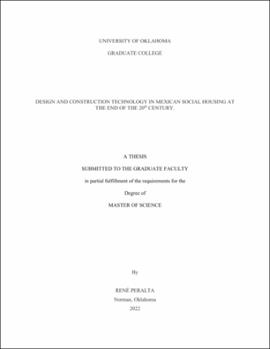| dc.contributor.advisor | Pilat, Stephanie | |
| dc.contributor.author | Peralta, Rene | |
| dc.date.accessioned | 2022-12-09T18:34:47Z | |
| dc.date.available | 2022-12-09T18:34:47Z | |
| dc.date.issued | 2022 | |
| dc.identifier.uri | https://hdl.handle.net/11244/336906 | |
| dc.description.abstract | This paper examines the role of construction systems in the success and failure of the Mexican government and the private sector in providing housing for the working class at the end of the 20th century. In this study, construction systems are examined that enabled developers to build thousands of housing units with significant sociocultural impacts on urban development in Mexican cities.
Based on evidence collected from governmental housing policy, interviews with individuals, technical manuals, and documentary film, this study demonstrates that construction technology at the end of the 20th century produced low-income neighborhoods as material assemblages that interacted with human desires during the global economic challenges of the period.
Keywords: Social housing, Mexico, monolithic construction technology, assemblage theory | en_US |
| dc.language | en_US | en_US |
| dc.rights | Attribution-NonCommercial-NoDerivatives 4.0 International | * |
| dc.rights.uri | https://creativecommons.org/licenses/by-nc-nd/4.0/ | * |
| dc.subject | Housing | en_US |
| dc.subject | Mexico | en_US |
| dc.subject | Construction | en_US |
| dc.subject | Technology | en_US |
| dc.title | Design and construction technology in Mexican social housing at the end of the 20th century. | en_US |
| dc.contributor.committeeMember | Cianfarani, Francesco | |
| dc.contributor.committeeMember | Soppelsa, Peter | |
| dc.date.manuscript | 2022-12-01 | |
| dc.thesis.degree | Master of Science | en_US |
| ou.group | Christopher C. Gibbs College of Architecture | en_US |

